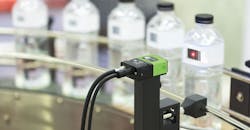Known for its handheld scanning devices, Zebra Technology Corp. has entered the fixed industrial scanning and machine vision markets with a new portfolio of solutions that enable track and trace capabilities and quality inspection of manufacturing work in process.
When developing its offering, the company spent a significant amount of time focused on creating a highly intuitive user interface with the goal of reducing training and deployment time. Known as Aurora, Zebra’s unified software platform that can easily set up, deploy and run both solutions - meeting businesses’ need for simplicity, speed, productivity and efficiency.
Zebra Aurora offers numerous unique features designed to drive efficiency and productivity through industrial automation processes. Tools like ImagePerfect+ help eliminate bypassed systems and false rejects by capturing perfect images created from up to 16 different images in one trigger event, each with its own unique settings. Meanwhile, Golden Image Compare enables rapid troubleshooting of failed image capture by comparing any image to a golden perfect image created at setup. Aurora also scales according to the application meaning manufacturers can start with a fixed industrial scanning license and upgrade to address certain kinds of machine vision jobs they may require later on – all while staying on the same platform.
Leveraging the same ultra-rugged stationary hardware, Zebra’s fixed industrial scanners and machine vision smart cameras can inspect production lines and product movement processes helping improve quality in manufacturing, warehouse and logistics environments.
“Zebra Technologies is excited to extend our 50-plus year legacy of data capture innovation and leadership with the introduction of our first suite of machine vision smart cameras and fixed industrial scanners for the industrial automation market,” said Donato Montanari, vice president of machine vision solutions, Zebra Technologies.
Entering the vision space is a natural transition for Zebra. “We have become specialists at helping manufacturers gain access to the data they need to make business decisions leveraging a host of edge devices transforming actionable information,” Montanari tells IndustryWeek. “When you read a barcode from a fixed scanner you take an image and transform it into numbers. And when you use a camera for quality control, you transfer the image into pass/fail or yes/no.”
The goal is to provide a performance edge to those on the front line of business with a simple, out-of-box experience and superior reliability that enables maximum visibility and the rapid transformation of image capture into actionable business information, explains Montanari. As such, Zebra’s flexible new portfolio includes seven fixed data capture products featuring a unique set of industrial scanning and/or machine vision capabilities. Businesses can choose the products that meet their needs today and upgrade at any time to add support for new barcode symbologies, increased scanning speeds, or advanced machine vision tools via the simple purchase of a software license.
While Montanari recognizes that the vision market is a large and mature industry growing at a very rapid pace, he is confident Zebra is up to the challenge. “Anytime you enter an existing strong industry, you face barriers and very focused competitors. We are addressing this issue by leveraging innovations in terms of our platform and features – an approach that has helped Zebra throughout its 50 years,” he says.
One relevant example separating Zebra from the pack – the decision to put a dual port ethernet on the cameras. “The idea is that we can connect to the PLC, while using the other port, for instance, to quickly and securely send an image to the cloud,” he says. “This opens the doors to a lot of new opportunities because now you have the images stored for offline evaluations and analysis, which can have meaningful impact on yield improvements, or prediction of defects.”
Since Zebra is already very present in these industrial spaces, Montanari also sees the ability to improve interoperability with the rest of its products including tablets, handhelds and printers as a meaningful advantage as well. “Looking ahead, interoperability will prove most value as organization look to maximize their IoT and Industry 4.0 investments,” he says.
AI will also enter the equation as the offering evolves – some of which it will address through strategic partnerships. “Fortunately, the camera already has an embedded neural network processor, so we know we have the opportunity of a running machine learning algorithms,” he says. “As we push the frontier of what can possibly be dealt with to include very esoteric algorithms, it will undoubtedly make sense to partner with somebody who specializes in those applications.”
About the Author
Peter Fretty
Technology Editor
As a highly experienced journalist, Peter Fretty regularly covers advances in manufacturing, information technology, and software. He has written thousands of feature articles, cover stories, and white papers for an assortment of trade journals, business publications, and consumer magazines.

